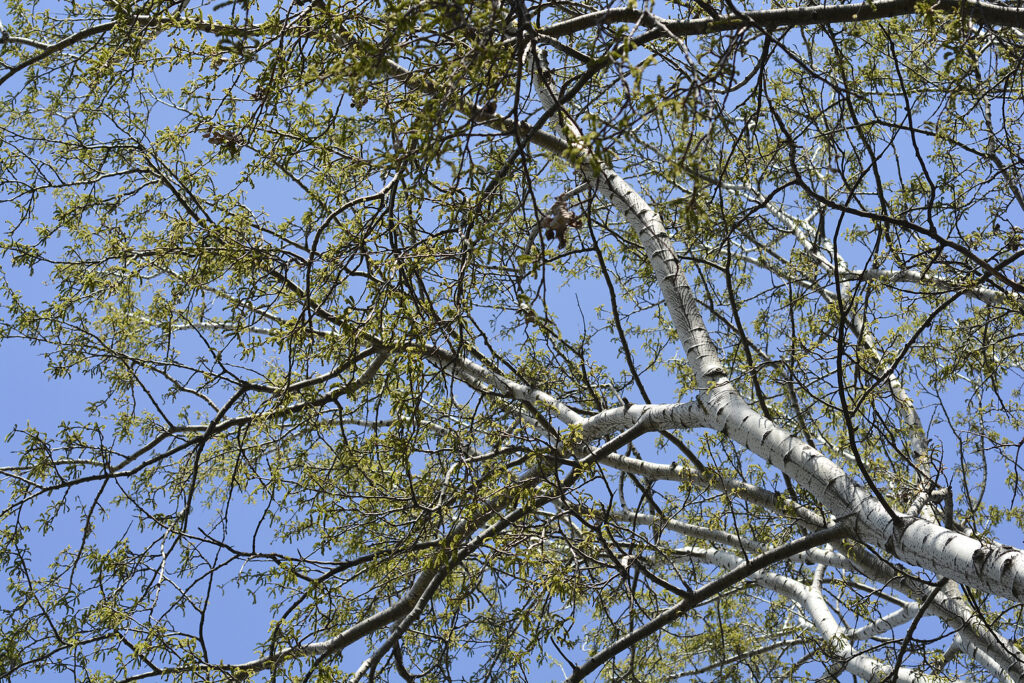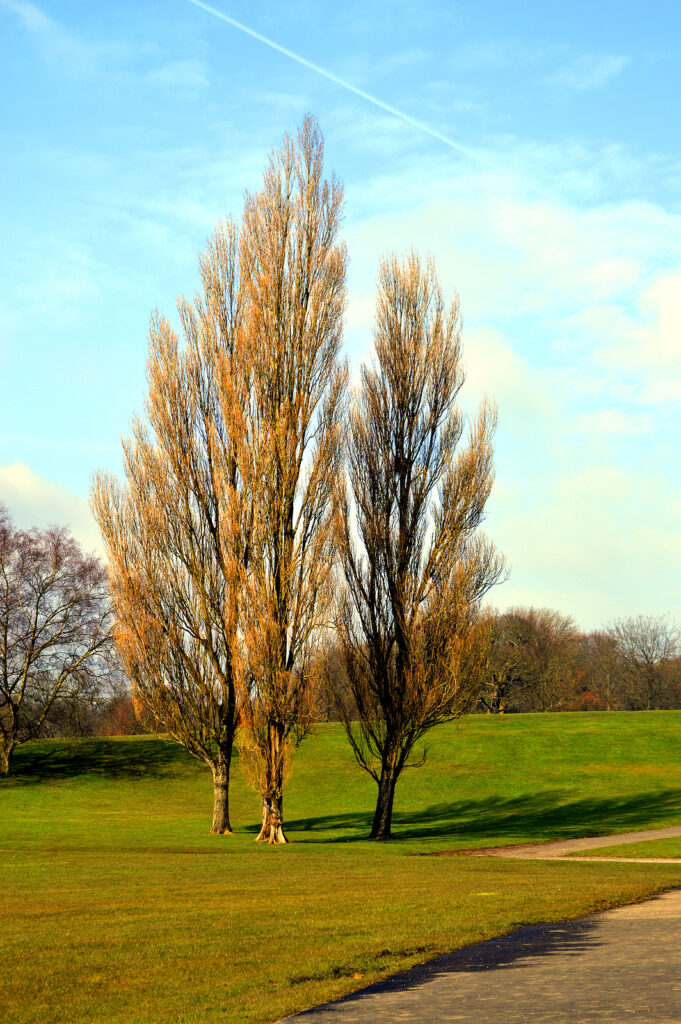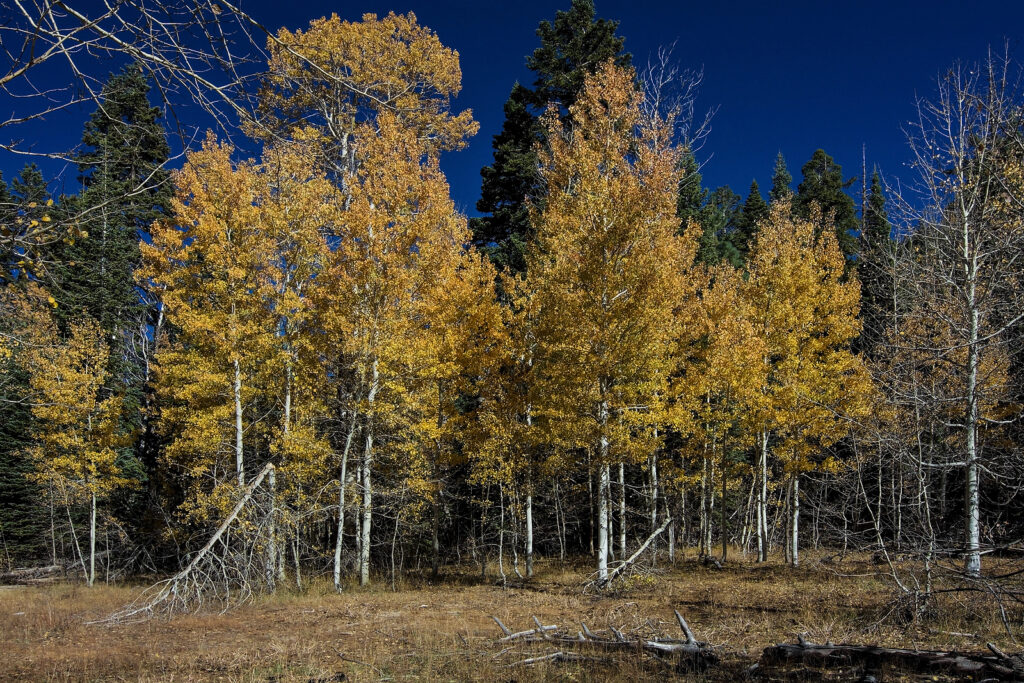Populus is a genus of trees commonly known as poplars, cottonwoods, and aspens. Members of the Populus genus are fast-growing, touch trees. They grow tall and need room; they are best suited for large properties and rural areas.
Populus are cultivated for their rapid growth and use as imposing specimen trees. They have ovate, triangular-ovate, and diamond-shaped leaves. They have tiny flowers borne in catkins to 6 inches (15cm) long. They often produce fluffy white seeds (“cotton”).
Populus have a network of aggressive surface toots that can crowd out other plants, heave pavements, and clog sewer and drainage lines. They sucker profusely.

Get to know Populus
- Plant type: Deciduous trees
- Growing zones and range: Zones 2 to 8
- Hardiness: Hardy to Zone 2 depending on the variety
- Height and width: To 90 feet (27m) tall and 100 feet (30m) wide
- Growth rate: Fast
- Form and habit:
- Foliage: Alternate leaves are roughly triangular, sometimes toothed or lobed, often aromatic; leaves flutter gracefully on long, flattened stems
- Flowers: Undistinguished tiny male and female flowers are borne in catkins on separate trees; female trees produce an abundance of fluffy white seeds that accumulate on the ground like bits of cotton
- Bloom time: Late winter or spring
- Uses: Screens, mass plantings, gardens in rural areas, specimen trees, windbreaks
- Garden companions:
- Common name: Poplars, Cottonwood
- Botanical name: Populus
- Family name: Salicaceae
- Origin: Woodland, valley bottoms, riverbanks, and swampland in Northern temperate regions
Where to plant Populus
- Plant Populus in full sun; tolerate light shade.
- Plant Populus in deep, moist but well-drained soil; tolerant of a variety of soil conditions, even poor, dry ones, but not waterlogged ones.
When to plant Populus
- Plant Populus in fall or spring.
- Sow seeds in summer.

Planting and spacing Populus
- Populus have invasive root systems and should be planted at least 30 feet (9.1m) from foundations, water pipes, sewer pipes, or septic systems.
- Their great thirst for water makes them invaluable in cleaning up sites damaged by polluted groundwater.
- Plant Populus in deep soil to accommodate the trees’ long root structures.
How to water and feed Populus
- Give Populus regular deep watering.
- Feed Populus with an all-purpose organic fertilizer in spring.

How to care for Populus
- Prune Populus in summer or fall; bleeds if pruned at other times.
- Most Populus will sucker profusely if their roots are cut or disturbed.
Populus pests and diseases
- Most Populus are weak wooded and susceptible to storm damage.
- Some Populus are susceptible to canker, so they are often short-lived; butt rot, crown gall, dieback, root rot, leaf blister, white rot, rust, and powdery mildew can also occur.
- Populus are susceptible to many pests and diseases such as borers, leaf miners, caterpillars, scale insects, and leaf hoppers.
- Keep soil evenly moist with organic mulch. Healthy plants will resist pests and diseases far better than stressed plants.
Populus propagation
- Take Populus cuttings in late summer or winter.

Populus varieties to grow
- Populus alba, White poplar, often grown as graceful, multitrunked clump, white poplar is a round-topped, spreading tree that grows quickly to 40-70 feet (12-21m) tall and wide. Leaves are 3-5 inches (7.6-12.7cm) across and three lobed, rather like a maple’s (Acer). They are shiny dark green on top, with a felt of white hairs on the undersides. The slightest breeze sets the leaves in motion, flashing a silvery light. Fall color is yellow. Trunk bark is a showy, grayish white and attracts attention all year. As trunks mature, they become marked with black. Though attractive, this tree is soft wooded, short-lived, and a bit messy, continually dropping leaves during summer and fall. It is best used to create quick shade in the Midwest and West, where few shade trees thrive. From Central Europe and Asia. Zones 4 to 9.
- P. deltoides, Cottonwood, pyramidal when young and becoming irregularly open and vase shaped with age, this tree has a low-branching trunk and grows 75-100 feet (23-30m) wide along watercourses in the West and Midwest. It has a rugged character and a massive silhouette, with its tall, stout trunk and big branches covered with deeply furrowed, brown bark. Leaves are trilergy sufferers. Female trees produce enormous amounts of cottony white seeds that float great distances and create quite a mess. Numerous seedlings can invade open areas and grow in seemingly hostile sites. Despite its drawbacks, cottonwood is one of the hardiest shade and shelterbelt trees fort the cold climates of the North, Plains, and Mountain States, where most trees have a difficult time growing. In the home landscape, a male, cottonless form is best, used only in large-scale situations and away from drainpipes. From central and western North America. Zones 3 to 9.
- P. freemontii, western cottonwood, Fremont cottonwood, is often seen near desert waterholes and watercourses; it grows 40 to 60 fee tall with thrick coarsley toolthe glossy yellow-green leaves that turn bright lemon yellow in fall.
- P. nigra, ‘Italica’, Lombardy poplar, this fast-growing cultivar of the wide-spreading black poplar tree reaches 70-90 feet (21.3-27.4m) tall and 10-15 feet (3.1-4.6m) wide. Its numerous upright branches give it the erect appearance of a telephone pole but make it useful as a quick screen or shelterbelt. Leaves are triangular and about 4 inches (10.2cm) long. They have light green undersides and turn bright yellow in fall. Trunk bark is gray-green on young trees, eventually becoming black on the lower trunk. Because this cultivar is susceptible to disease when mature, consider using it only as a temporary planting in a new landscape, or choose a similar but more disease-resistant cultivar or a columnar form of another tree such as a maple. Zones 3 to 9.
- P. tremula, European aspen, is sometimes called Swedish columnar aspen. It is narrow like the Lombardy poplar bus has red fall color.
- P. tremulides, quaking aspen, grows 40 to 50 feet tall and 20 to 30 feet wide; it often has several trunks or grows in a clump; it has smooth, pale gray-green to whiteish bark and small round light gree leaves that flutter and quake in the slightest breeze; it has brilliant golden yellow fall foliage.
- P. trichocarpa, black cottonwood, is a tall spreading tree that can grow to 40 feet tall in 15 years; it can grow to 180 feet tall in old age; it is heavy limbed with dark gray, furrowed bark; leaves can be 3 to 5 inches across–they are deep green abvoe the distinctly silver beneath; this tree has golden yellow fall color.















